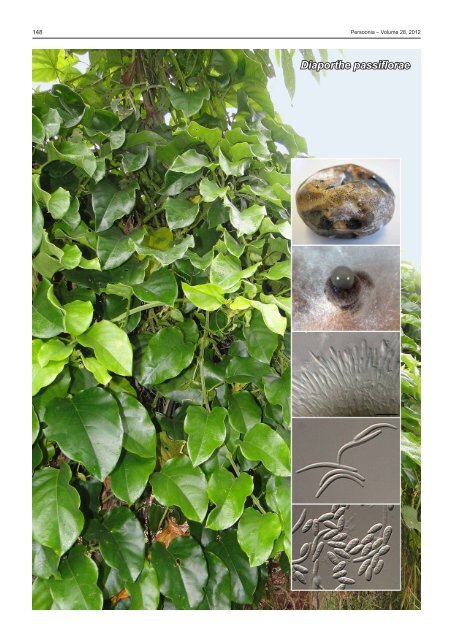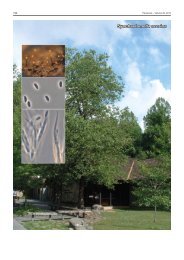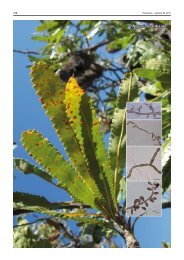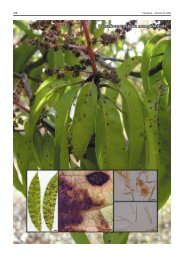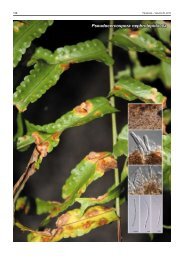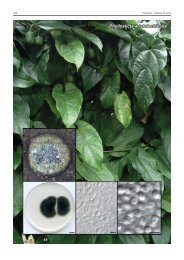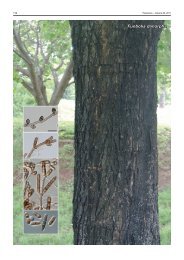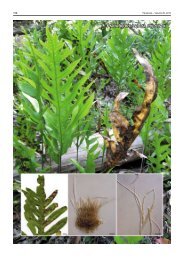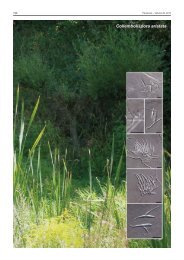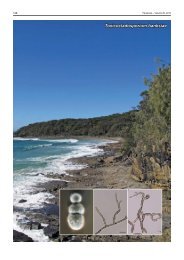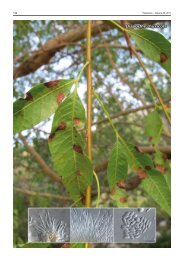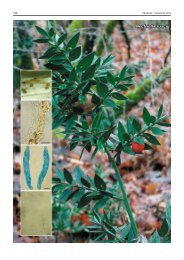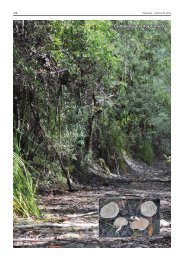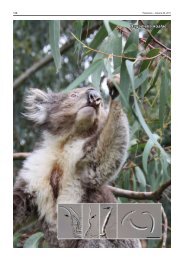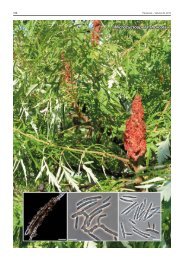Diaporthe passiflorae - Fungal Planet
Diaporthe passiflorae - Fungal Planet
Diaporthe passiflorae - Fungal Planet
You also want an ePaper? Increase the reach of your titles
YUMPU automatically turns print PDFs into web optimized ePapers that Google loves.
148 Persoonia – Volume 28, 2012<br />
<strong>Diaporthe</strong> <strong>passiflorae</strong>
<strong>Fungal</strong> <strong>Planet</strong> description sheets<br />
149<br />
<strong>Fungal</strong> <strong>Planet</strong> 111 – 4 June 2012<br />
<strong>Diaporthe</strong> <strong>passiflorae</strong> Crous & L. Lombard, sp. nov.<br />
Etymology. Named after the host genus on which it occurs, Passiflora<br />
edulis.<br />
Sporulating on the surface of an old granadilla fruit (endophyte?).<br />
Pycnidia in culture on oatmeal agar sporulating poorly,<br />
globose, up to 300 µm diam, black, erumpent; cream conidial<br />
droplets exuding from central ostioles; walls consisting of 3–6<br />
layers of medium brown textura angularis. Conidiophores<br />
hyaline, smooth, 2–3-septate, branched, densely aggregated,<br />
cylindrical, straight to sinuous, 20–30 × 2.5–4 µm. Conidiogenous<br />
cells 7–15 × 1.5–2.5 µm, phialidic, cylindrical, terminal<br />
and lateral, with slight taper towards apex, 1–1.5 µm diam, with<br />
visible periclinal thickening; collarette not flared, up to 2 µm<br />
long when present. Paraphyses not observed. Alpha conidia<br />
aseptate, hyaline, smooth, guttulate, fusoid to ellipsoid, tapering<br />
towards both ends, straight, apex subobtuse, base subtruncate,<br />
(5.5–)6–7(–8) × (2–)2.5–3(–3.5) µm. Gamma conidia aseptate,<br />
hyaline, smooth, ellipsoid-fusoid, apex acutely rounded,<br />
base subtruncate, 10–12 × 2–2.5 µm. Beta conidia spindleshaped,<br />
aseptate, smooth, hyaline, apex acutely rounded, base<br />
truncate, tapering from lower third towards apex, curved, (14–)<br />
16–18(–20) × 1.5(–2) µm.<br />
Culture characteristics — (in the dark, 25 °C, after 2 wk):<br />
Colonies fluffy, with abundant aerial mycelium, covering the<br />
dish within 2 wk; on oatmeal agar, malt extract agar, and<br />
potato-dextrose agar, surface dirty white, with patches of pale<br />
olivaceous grey.<br />
Typus. South America, imported into the Netherlands, on fruit of Passiflora<br />
edulis (Passifloraceae), Apr. 2011, P.W. Crous, holotype CBS H-20956, cultures<br />
ex-type CPC 19184, 19183 = CBS 132527, ITS sequence GenBank<br />
JX069860 and LSU sequence GenBank JX069844, MycoBank MB800372.<br />
Notes — Phomopsis rot of Passiflora edulis (granadilla) has<br />
traditionally been linked to infections of P. tersa, which damages<br />
the leaves, fruit and twigs, causing losses of up to 40 %<br />
(Lutchmeah 1992). Phomopsis tersa has been confirmed from<br />
countries such as Portugal, Malta, Mauritius, Sarawak, Sri<br />
Lanka, and Fiji (Sutton 1980, Lutchmeah 1992). Two to three<br />
days following harvest, the stalk collapses, and turns brown.<br />
Within 10 d, the whole fruit is affected, and black conidiomata<br />
are observed on the fruit surface (Lutchmeah 1992). Conidia of<br />
D. <strong>passiflorae</strong> are much larger (14–20 × 1.5–2 µm) than those<br />
of P. tersa (6.5–7.5 × 2.5 µm) (Sutton 1980).<br />
Based on a megablast search of NCBIs GenBank nucleotide<br />
database, the closest hit using the ITS sequence is <strong>Diaporthe</strong><br />
phaseolorum (GenBank EU272513; Identities = 597/612<br />
(98 %), Gaps = 7/612 (1 %)), followed by Phaeocytostroma<br />
ambiguum (GenBank FR748042; Identities = 597/634 (94 %),<br />
Gaps = 18/634 (3 %)), and <strong>Diaporthe</strong> phaseolorum var. caulivora<br />
(GenBank AF000567; Identities = 579/609 (95 %), Gaps<br />
= 12/609 (2 %)). Closest hits using the LSU sequence yielded<br />
highest similarity to <strong>Diaporthe</strong> leucospermi (GenBank<br />
JN712524; Identities = 920/928 (99 %), Gaps = 0/928 (0 %)),<br />
followed by <strong>Diaporthe</strong> cynaroidis (GenBank EU552122; Identities<br />
= 910/921 (99 %), Gaps = 2/921 (0 %)), and <strong>Diaporthe</strong><br />
rhusicola (GenBank JF951166; Identities = 915/932 (98 %),<br />
Gaps = 2/932 (0 %)).<br />
Colour illustrations. Passiflora edulis in Brazil (Photo by A.C. Alfenas);<br />
diseased granadilla with pycnidia; pycnidium sporulating in culture; conidiogenous<br />
cells, beta and alpha conidia. Scale bar = 10 µm.<br />
© 2012 Nationaal Herbarium Nederland & Centraalbureau voor Schimmelcultures<br />
Pedro W. Crous, Lorenzo Lombard & Johannes Z. Groenewald, CBS-KNAW <strong>Fungal</strong> Biodiversity Centre, P.O. Box 85167,<br />
3508 AD Utrecht, The Netherlands;<br />
e-mail: p.crous@cbs.knaw.nl, l.lombard@cbs.knaw.nl & e.groenewald@cbs.knaw.nl


